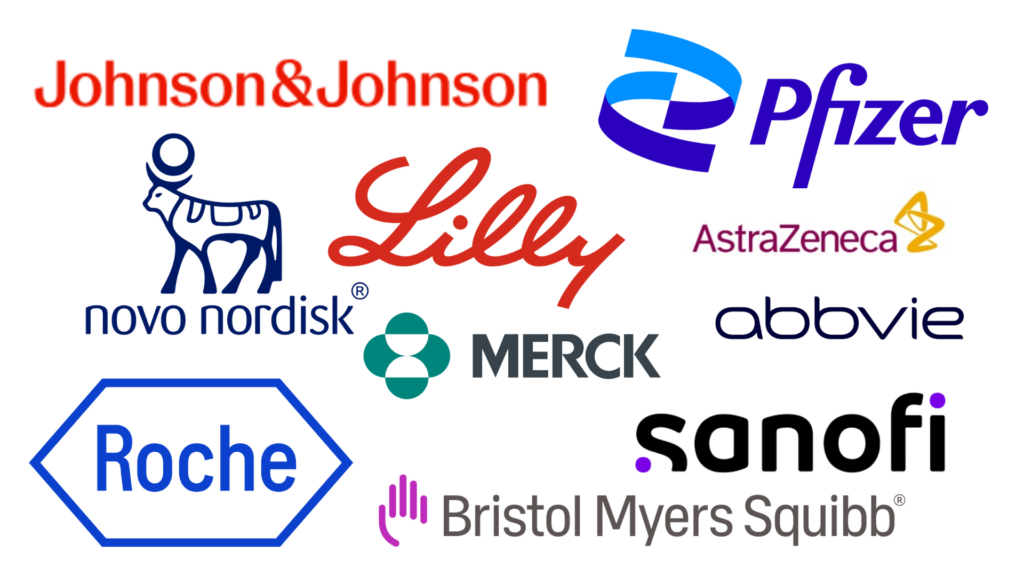The pharma and biotech sectors have been leaders of innovation and economic growth in 2024. As this industry navigates evolving healthcare demands, it demonstrates remarkable resilience. This trend aligns with the broader surge in biotech stocks, which have outperformed many other sectors this year, fueled by a series of high-impact drug approvals, mergers and a promising pipeline of next-generation therapies.
Companies like Eli Lilly and Novo Nordisk have achieved notable milestones in the treatment of diabetes and obesity. These breakthroughs, combined with the growing focus on gene therapy, oncology and immunology, have brought these companies to the forefront of global healthcare.
This blog highlights the top 10 largest publicly traded pharma and biotech companies by market capitalization in 2024, showcasing their influence and contributions to global health.
1. Johnson & Johnson (JNJ)
Market Capitalization: $402.1 Billion
Johnson & Johnson, a global healthcare giant, tops the list with a diverse portfolio spanning pharmaceuticals, medical devices and consumer health products. The acquisition of V-Wave strengthens its cardiovascular portfolio, while US Food and Drug Administration (FDA) submissions for Spravato (esketamine) as a monotherapy for adults with treatment-resistant depression and nipocalimab for antibody-positive generalized myasthenia gravis signal its commitment to addressing unmet medical needs.
2. Novo Nordisk (NVO)
Market Capitalization: $377.2 Billion
Novo Nordisk, a leader in diabetes care, continues to expand its impact globally. The company’s first-half 2024 sales surged 24 percent, driven by high demand for glucagon-like peptide-1 (GLP-1)-based treatments for diabetes and obesity, such as Wegovy (semaglutide). The recent partnership to produce affordable insulin in Africa aims to reach over four million people by 2026, reflecting Novo Nordisk’s commitment to global health equity.
3. Eli Lilly (LLY)
Market Capitalization: $353.3 Billion
Eli Lilly continues to strengthen its market position with innovative therapies and strategic acquisitions. Eli Lilly raised its full-year revenue forecast due to strong demand for Mounjaro (tirzepatide). Tirzepatide also showed a 94 percent reduction in the risk of developing type 2 diabetes in high-risk adults in a Phase III study. Lilly also acquired Morphic bringing Omvoh (mirikizumab) into their portfolio for ulcerative colitis and possibly Crohn’s disease.
4. Roche (RHHBY)
Market Capitalization: $293.5 Billion
Roche, leading in pharmaceuticals and diagnostics, showed increased sales with Vabysmo (faricimab-svoa) for certain eye diseases emerging as a significant growth driver. Roche secured FDA and European Commission approval for Alecensa (alectinib) as the first targeted adjuvant monotherapy for anaplastic lymphoma kinase (ALK)-positive non-small cell lung cancer (NSCLC). The company also expanded its diagnostic capabilities through the acquisition of LumiraDx’s Point of Care technology, enhancing access to decentralized testing globally.
5. Merck & Co. (MRK)
Market Capitalization: $280.4 Billion
Merck, renowned for its contributions to immunotherapy, remains a towering force in oncology with its blockbuster drug, Keytruda (pembrolizumab). In Europe, Merck received positive opinions from the European Medicines Agency’s (EMA) Committee for Medicinal Products for Human Use (CHMP) for Keytruda combined with Padcev (enfortumab vedotin) as a first-line treatment for urothelial carcinoma. Merck also expanded its oncology pipeline through a global collaboration with Daiichi Sankyo for MK-6070, aimed at treating small cell lung cancer (SCLC) and other neuroendocrine tumors.
6. Pfizer (PFE)
Market Capitalization: $254.7 Billion
Pfizer, a powerhouse in pharmaceuticals, has seen significant growth in 2024, driven by the legacy Seagen products acquired through Pfizer’s $43 billion acquisition of Seagen Inc. The acquisition positioned Pfizer as a leading oncology company, enhancing its portfolio with Seagen’s four key antibody-drug conjugate (ADC) medicines. Pfizer is also making strides in vaccines, advancing Abrysvo for treating respiratory syncytial virus (RSV) infections, which has shown strong immunogenicity in immunocompromised adults.
7. AstraZeneca (AZN)
Market Capitalization: $248.6 Billion
AstraZeneca thrives in the oncology and cardiovascular, renal and metabolism (CVRM) space, with revenues increasing significantly in both areas. The company achieved key regulatory milestones, including the FDA approval of Imfinzi (durvalumab) for resectable early-stage NSCLC and approvals of Tagrisso (osimertinib) with chemotherapy for first-line EGFR-mutated NSCLC in the US, European Union (EU), Japan and China.
8. AbbVie (ABBV)
Market Capitalization: $240.9 Billion
AbbVie, a leader in immunology and oncology, is making waves through key contributions by Skyrizi (risankizumab) and Rinvoq (upadacitinib). The acquisition of ImmunoGen in February 2024 expanded AbbVie’s oncology pipeline with novel ADCs, including Elahere (mirvetuximab soravtansine) for platinum-resistant ovarian cancer. AbbVie’s pipeline continues to develop, with positive Phase III results for Rinvoq in Crohn’s disease.
9. Bristol Myers Squibb (BMY)
Market Capitalization: $217.3 Billion
Bristol Myers Squibb (BMS), known for its strong oncology portfolio, reported revenues of $12.2 billion in the second quarter of 2024, driven by key oncology products like Opdivo (nivolumab) and Reblozyl (luspatercept). The EMA validated Opdivo plus Yervoy (ipilimumab) for hepatocellular carcinoma and Breyanzi (lisocabtagene maraleucel) for follicular lymphoma. BMS also announced positive Phase III results for cendakimab in eosinophilic esophagitis, further advancing its pipeline.
10. Sanofi (SNY)
Market Capitalization: $172.8 Billion
Sanofi rounds out the top ten, with a solid presence in vaccines, rare diseases and specialty care. Sanofi dominates the market with Dupixent (dupilumab), due to high demand across indications like atopic dermatitis, asthma and chronic rhinosinusitis with nasal polyps. The recent EU approval for chronic obstructive pulmonary disease (COPD) made Dupixent the first biologic for this condition. Pharma launches, including Altuviiio (efanesoctocog alfa) for hemophilia A, saw significant growth, keeping Sanofi at the forefront of the global healthcare industry.
These top 10 publicly traded pharma and biotech giants are at the forefront of healthcare innovation. Their relentless pursuit of advancements in drug development, disease prevention and therapeutic interventions is reshaping the future of global healthcare. As they tackle chronic and emerging health challenges, their efforts hail a promising outlook for a healthier world.












Join or login to leave a comment
JOIN LOGIN